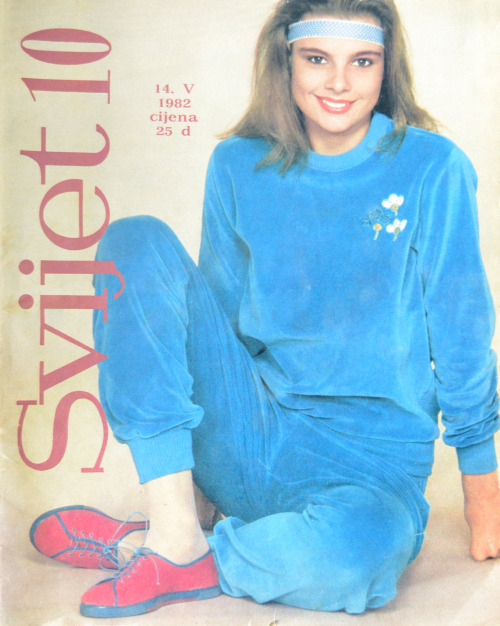Only one group of humans was condemned to a life of domestic work, childrearing, babysitting. The other can have a siesta and moods. Svijet magazine was the first to inform me this is not the natural order of things.

How often are we able to pinpoint the exact event in time when we adopted a belief or a value? I expect not frequently, but I can see myself age 11, this would be mid-1980s, leafing through the magazine Svijet, getting an inkling that something was off and unfair and arbitrary about female lot. I’d spotted a strange asymmetry in my parents’ lives by then: They both worked outside the home, but only one of them continued to work after coming home from work, her remaining eight waking hours taken up by domestic chores, planning and care for the other four family members.
The workday in the communist Yugoslavia ran from 6 a.m. to 2 p.m., or 7 a.m. to 3 p.m., the working population home for lunch. That consumed, our father would withdraw for his siesta, while my mother proceeded to do the washing, cleaning and next day meal planning. As my much older sisters came of age, each was assigned a role in the domestic workforce. By dint of chromosomal distribution, it seemed, absolutely non-negotiably, only one group of humans was condemned to a life of domestic work, childrearing, babysitting—and humoring. The other group can have a daily siesta, and can have moods around which the rest of the family will have to work.
Svijet was the first to inform me that this is not a natural, god-given order of things. Published in Zagreb, distributed widely across Yugoslavia, Svijet was at its most feminist at the time I discovered it, although it’s been around since 1950s. The coolest women among my sisters’ and mom’s friends were reading it, and that’s probably what prompted me to take a peek. Soon enough I was spending my pocket money on magazines, and the walk home from school would usually end with a hangout at the kiosk. A lot of things that I read in Svijet went over my head, but what I understood thrilled me, and what I half-understood made me want to work for it.
It looked like a typical commercial women’s magazine—except that between the recipes, fashion, home decor and tailoring and needlepoint patterns there were articles on the work-life double shift for employed women. There were articles on issues that women encounter at their workplaces, in school or at university; pieces on travelling or hitchhiking solo; coverage of issues around reproductive and other health, and women and aging; and I even remember an article about a rare creature in Yugoslavia back then (and in its inheritor states to this day), an out lesbian.
As young Croatian sociologist Mia Gonan documents in her 2014 graduation thesis, Svijet has been making forays into feminist line of questioning since the late 1960s. Created as a glamourous plaything for modernist graphic designers of 1950s, addressing an educated, well travelled and aspirational middle class that Yugoslavia did not yet have at that time, Svijet gradually sobered and de-glossified visually—but what it gave up on visual luxe it more than made up for in luxuriously smart writing, the vast majority of which was by women.
It’s where I first discovered Slavenka Drakulić. She would later, on the arrival of nationalists to power in Croatia, be declared one of the unpatriotic witches who ‘defame’ Croatia, alongside Dubravka Ugrešić, Rada Iveković, Vesna Kesić and Jelena Lovrić, but my teens luckily coincided with her most prolific phase in Svijet and Start. Drakulić was also, I would soon find out, contributing columnist in the U.S. magazine The Nation.
Svijet was where I first read Susie Orbach’s Fat is Feminist Issue, translated and serialized, and where I first discovered Margaret Drabble, whose The Millstone got smuggled into the section where the readers usually expect a romance novel.
I first heard of Patricia Highsmith’s Edith’s Diary because Svijet wrote about it (I’d read this, her best book, many years later, in English).
At a Venice Film Festival Patricia Rozema premiered I’ve Heard the Mermaids Singing, and I’ve learned about it because Svijet had a correspondent in Venice. (I would move to Toronto, where the movie is set, some 15 years later.)
How old was I in 1987? 13. Svijet was international, outward looking, broadly socialist but within that as liberal as it was possible, and filled with exquisite arts journalism. It introduced me to Proust, who wasn’t in the school curriculum, and Balzac, who was, but it was Svijet that made him attractive. I still remember the essay on the art of gossip which used examples from several Balzac novels to illustrate its gold standard.
Most of all, it was feminist. It even had a regular Gloria Steinem column one year, I presumed written in English specifically for Svijet and then translated. There was a certain tension in Yugoslavia between the official ideology of communism and feminism which properly emerged only in 1980s, at the time of ideological thawing and economic crisis. The woman question was presumed solved in communism with the introduction of a ‘classless’ welfare state. And many problems indeed have been. The communists created a publicly funded kindergarten-to-university education system, free at point of access healthcare system, they nationalized infrastructure, housing development and resource extraction, they industrialized the previously rural and illiterate society, all of which in due course created a stable middle class, effectively the first the region has seen in its history, and a 45-year-long peacetime. Abortion was legal and safe, and there was no outrageous gender pay gaps, although pink industrial ghettos, e.g. the textile industry, did exist.
But the domestic sphere remained female. It would never have occurred to the partisans who built the country to think that equality meant equality in the division of labor at home. It did not compute. The partisan Amazon, woman who can do all a man can, who was the essential part of the people’s liberation movement and the post-war reconstruction—was also completing all the domestic and child-rearing chores exemplarily.
The woman question was presumed solved in communism with the introduction of a ‘classless’ welfare state. It would never have occurred to the partisans who built the country to think that equality meant equality in the division of labor at home. It did not compute.
As Yugoslavia was falling apart, and I was reaching my 20s and starting university, the feminist epicentre transferred to Belgrade. (Svijet by that time was kaput; the newly independent Croatia called for different media.) Somewhere in mid-1990s I registered to attend the classes at the recently formed, foreign-NGOs funded (that was the only way) Women’s Studies Centre and that too was life changing. Various other women-centred NGOs emerged within the fragile civil society in Serbia under economic sanctions and Milošević. Daša Duhaček was one of the WSC founders, Belgrade-based philosopher who specialized in Hannah Arendt. Among its instructors the Centre counted people like Žarana Papić, Jasmina Lukić, Marina Blagojević, Lepa Mladjenović and Branka Arsić, now a Columbia University Prof and author of books on Emerson and Thoreau, back then one of the few people anywhere who knew the first thing about Deleuze and could actually teach him. Women’s Studies Centre in Belgrade is where I first encountered the legend that was Ann Snitow, a NYC radical feminist of the Second Wave and co-founder of the Network of East-West Women which for years, yonks before online shopping, sent free books on request to women in countries in transition through the Network’s Book and Journal Project.
Feminism in the ethno-nationalist and war-torn 1990s found itself in the anti-war camp, and therefore even more marginalized than previously. While during communism it was seen as somewhat bourgeois and western, in the nationalist era feminism was too Yugo, too international and socialist. The small anti-war group in Serbia called ‘Women in Black’ was particularly hated in 1990s and still is. I can’t explain why a dozen silent women wearing the colour of bereavement incite such rage. Have a look at what happened a few years ago when Daša Duhaček, by then-professor at my alma mater, the faculty of political science at Belgrade University, was about to open a talk by the guest speaker from the Serbian WiB, Staša Zajević. Or this recent counter-protest—something that follows them around frequently now—by the fans of the convicted Bosnia war criminal Ratko Mladić in central Belgrade.
When the NATO started its bombing campaign due to Serbia’s war in Kosovo, it was time to leave Belgrade and return to my parents’ home in Montenegro. Not a lot was going on in the way of feminism in Montenegro so I sent the arts editor of the daily Vijesti some clippings and pitched a series called Introducing Feminist Thought. He was game, and the series ran every weekend of that otherwise bleak post-NATO summer of 1999. I would soon move to Canada, and when I returned in 2003-4 to renew my visa, there were already important feminist figures in Montenegro’s public life, like Ljiljana Raičević, the founder of the first Montenegrin shelter for women fleeing domestic violence and—the scandal involving local potentates was about to explode—sex trafficking. Next time I looked, circa 2016, Montenegro had a bunch of organizations both grassroots and NGOs, and feminists had a place at conference tables and in the media. There is even a lively gay rights activism ecosystem now, which inspired me to write about lesbian and bi women of Montenegro for Ms. magazine (founded by Gloria Steinem… the international ties continue to intertwine).
Whether women’s position in South Slav societies has significantly improved since 1980s is certainly a conversation to be had. I think there is still so much left to do, especially in my own country, Montenegro. But to have all these roads paved by the women who came before us is half the job done. Feminism is here to stay.
Up next:





